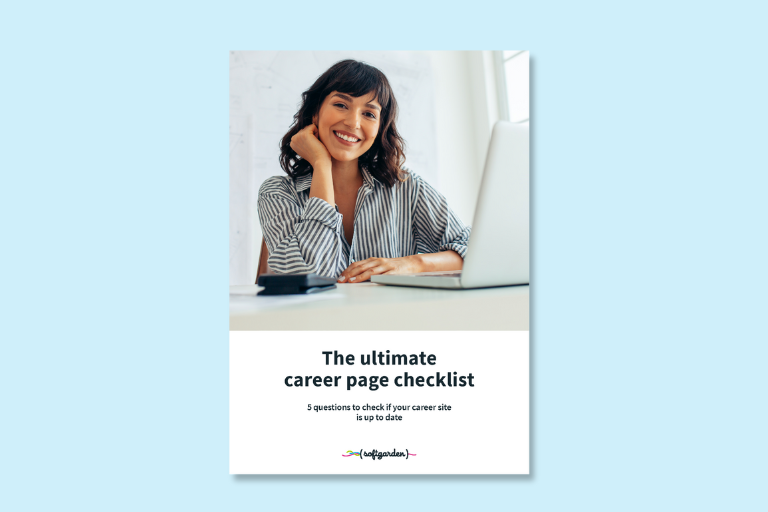Creating a convincing careers page is crucial today to attract qualified applicants. According to our surveys, 96 % of applicants research potential employers on their career site.
This article shows how companies can strategically design their career site to attract top talent: from modern web design and a clear information structure to SEO optimisation, the integration of vacancies and simple application options. Best practices, usability tips and performance measurement round off the guide – including a free checklist for implementation.
Contents
What is a career page?
Today, career pages should be an integral part of every recruiting strategy. This is where potential applicants can get an impression of your company, but also of the positions advertised in your organisation. Ideally, your career page should provide talented candidates with all the necessary information about you as an employer that is crucial for an application. The technical requirements should also be in place so that they can apply to you directly, including via mobile. A well-designed careers page turns interested visitors into applicants.
By the way: When we talk about ‘career site’, ‘career homepage’, ‘career website’ or ‘career website’ in the following, we mean the same thing, even if they are traditionally used to describe different things in web design.
Why is a careers page important?
Anyone looking for a job today wants to find out about an employer on an invitingly designed careers website. According to our ‘Candidate Experience 2020’ survey, more than one in five applicants (25.6 %) start their job search right here. The rest of the candidates use job boards, Google, social media, the daily press or employer review platforms.
However, this does not mean that the job search will not lead these candidates to the careers page at some point during their further research into an employer. Employers should therefore not underestimate the importance of a clearly organised careers page for their recruiting Jobseekers are used to being able to search the web for the right information in all areas of their daily lives.
They expect the same when looking for a job. Accordingly, a carelessly designed careers page or the absence of a careers page is perceived as a lack of interest on the part of the employer. A missed opportunity!
SEO: Design your career page for Google & Co
However, your career section must first be found by candidates. A good ranking on Google is therefore extremely important – and this is where search engine optimisation comes into play. What do you need to consider for your SEO?
Use keywords
It is crucial that your career page is found under the terms that your candidates are searching for. These are usually keywords such as ‘career’ + a specific job title + the name of your company. You should consciously use these search terms when creating the content of your careers page.
They should appear in the headings, in the body text, in the meta description and in the HTML title. It is also worth naming the images you use with keywords or related search terms before you upload them. If this is not the case, you are wasting valuable potential on Google and will be much harder or impossible to find.
If, on the other hand, you pay attention to these small basics of search engine optimisation, your career page will experience a real boost.
Importance of Google search
In this way, you can also reach talented people who would not have become aware of you via other application channels, as our survey ‘Job search in the age of Google Jobs’ shows. For example, one of our survey participants said: “I often find unexpected potential employers (on Google) that I wouldn’t have found on niche sites. It broadens the scope of possibilities.” All of this depends on how well you consider the search needs of your target audience when designing your careers site.
Overall, candidates are in favour of a very active approach to Google and have the following recommendations for employers:
‘Your job listings should come up on the first page of Google when people search the appropriate terms.’
‘Be listed as high as possible in Google and indicate on the homepage of your own company website that you are currently looking for employees.’
Another expert tip: By integrating real applicant feedback or employer reviews into your website, you have another SEO booster in your hand.
Google rates the relevant information as very valuable and helpful content and rewards career sites with reviews with a better ranking. Reviews are also a key decision criterion for applicants: our ‘Candidate Experience 2020’ study showed that 59 % of candidates are more likely to click through a careers website with integrated employer reviews.
Designing a careers page: The most important facts at a glance
The best careers pages present important information clearly,
- are well structured and easy to navigate,
- are immediately recognisable visually as part of the company website,
- allow a quick application directly on the page and load quickly.
Prepare important information clearly
However, a good ranking of your careers website on Google is only half the battle. Once candidates have found your careers page, they want to find all the information that is relevant to them. Good careers pages provide as transparent an insight as possible into the working environment of the company in question.
Describe which tasks you cover within your industry and what makes you unique. In addition to a detailed company description, according to our ‘Candidate Experience 2020’ survey, talents also want to find out what you stand for as an employer on a careers page and find out about the following aspects:
| Criteria | Share of mentions in % |
|---|---|
| Education and training, career opportunities | 53.3 |
| Company culture as an employer | 49.7 |
| Information on products and services | 47.8 |
| Information on benefits and work-life balance | 30.7 |
| Information on the company’s commitment to the environment or social projects | 11.1 |
| Images or videos of the workspaces | 7.4 |
On your career page, you have the space to offer your visitors information on all of these aspects.
However, make sure you convey an authentic image to the outside world. For example, embed photos and videos from your company.
Important note: Regardless of whether it’s a moving image or photo, it’s essential to avoid using stock images or video clips – only show authentic images of your employees and workplaces.
Showcase the people who make up the company. Moving images in particular arouse great interest among employees. For example, almost 70 % of talented people are more likely to apply for a job advert integrated into the careers page if a video is embedded in it.
You can also emphasise your credibility by embedding company reviews from employees and applicants. As a result, you present yourself as an attractive employer and optimise your employer branding.
Use recruiting key performance indicators as an argument
You can also integrate important recruiting key performance indicators (KPIs) in vivid graphics, for example:
- ‘10 days to interview’
- ‘4 weeks to hire’
- ‘564 job offers online’
The impact of this information is very strong. Clear information on the duration of individual process steps creates trust. Accordingly, a page with clearly communicated KPIs is clicked on by 74.4 % of applicants. Without this information, an otherwise identical career website is only selected by 25.6 %.

Subpages for different professional groups
A little tip on the side: If your careers page is aimed at many different professional groups or career levels, it is a good idea to create separate careers pages for the respective target groups.
This makes it clearer for talented people. After all, working conditions, benefits and other factors can be very different for a payroll accountant and an industrial clerk.
Include open positions directly on the careers page
Another thing that should not be missing on the careers page is a job portal with the current open positions.
It’s essential to avoid ‘dead bodies’, i.e. positions that have expired. This makes your job portal look untidy and does not leave a good impression.
Make your job advertisements as informative as possible. In addition to detailed job descriptions, provide talents with the following information:
- In which department is the desired position located and who is in charge of it?
- What tools and methods are used in the department?
- Who are my contacts for questions before and during the application process?
- For which location are you looking for employees?
Easy application
Once you have convinced your visitors, you should make it possible for them to apply directly via your job advert – regardless of where they are and which device they are using to access the job advert.
Offer candidates who are on a laptop, tablet or PC, for example, an easy-to-complete application form that is tailored to the job in question and only asks for relevant facts.
Alternatively, you can offer mobile candidates the one-click application. This allows you to import the data from your own Xing or LinkedIn profile into the applicant tracking system used.
Candidates can also upload a CV in PDF format. Its contents can be read out with a CV parser at the touch of a button and stored in the talent’s applicant file.
This has advantages for everyone involved. Candidates can send an online application with just a few clicks and recruiters receive optimised data that they can process directly.

Best practices career page design
Now let’s talk about the design of your career page.
A widespread faux pas made by many companies: They have a careers page, but it is strikingly different from the actual website.
Talents who access the careers page via a company’s homepage inevitably experience a media break and ask themselves: ‘Am I still in the right place?’
You should avoid such an inconsistent appearance at all costs and align your careers page with your company’s corporate identity.
Otherwise, you run the risk of candidates leaving because they no longer feel they are on the right page. What you should bear in mind:
- Use the same main, secondary and accent colours and the same fonts
- Make sure that the content is structured consistently with headings and font size grading across all pages
- Don’t forget the company logo
Usability and candidate experience
It is also important to optimise the usability, i.e. user-friendliness, of your website.
For example, improve the candidate experience by offering candidates various filter options on your job portal – by position, career level, location or full/part-time.
This allows talents to find the job that suits them directly. In addition to the aforementioned images and videos, informative graphics, lists and enumerations as well as prominent headings are important visual anchor points that make it easier to quickly scan appealing career pages.
Also very important: Nothing is more annoying than a page that loads slowly. Compress images and videos to avoid long page loading times. As a result, candidates will be faced with a careers page that is tidy and user-friendly.
Analyse the performance of your career site
However, once your career site is online, you should not take it for granted.
Instead, utilise the various analysis options to continuously improve your site. Here are some of the most important KPIs to help you do this:
- Conversion: How many applications do you receive via the site?
- Impressions: How many people have visited the page?
- Conversion rate: Ratio of the number of conversions to the number of impressions
- The ratio of new to returning visitors
- Traffic sources: the origin of your site visitors
- Conversion sources: What source did the site visitors who ended up applying come from?
- Hires: How many candidates do you ultimately hire via the career site channel?
Used correctly, these recruiting metrics are an effective tool for measuring, evaluating and ultimately improving the performance of your career site.
Free download
The ultimate career page checklist
Use our free checklist and check whether your career site is up to date by answering 5 questions and get valuable tips on how you can further optimize it.

Conclusion
There are a few key points that you should bear in mind when designing your careers page.
However, the investment of time and resources is well worth it. Bear in mind that you are creating an independent portal for recruiting new employees.
There is also software that makes setting up and maintaining a careers site very easy: softgarden’s Careers Page Pro has everything you need.
Without any prior knowledge of web development, you can create a convincing employer presence in a corporate design that allows you to present yourself perfectly to mobile candidates.
Job advertisements published via our applicant tracking software appear immediately on your careers page, and all changes are automatically and continuously synchronised.
Applicants can also apply for your vacancies from the careers page thanks to the integrated instant application. Further features:
- Easy creation of subpages that can be advertised via Google Ads
- HTML structure built according to SEO best practice
- Integration of recruiting KPIs such as response times or time-to-hire
- Numerous design options for customisation
The Career Site Pro is optimised for search engines so that candidates can find you faster. It couldn’t be simpler.









